Alison Krauss is THE gold standard in pitch control
42 Grammy nominations do not lie.
Pitch Control
Pitch control refers to the process of altering or regulating the pitch (the perceived frequency of sound) of an audio signal. This concept is widely applied in various contexts, including music production, performance, and playback of recorded audio. The ability to control pitch is crucial for a range of applications, from simple entertainment purposes to complex musical composition and sound design techniques.
Applications of Pitch Control
Music Production and DJing: One of the most common applications of pitch control is in music production and DJing. Turntables, CDJs, and digital audio workstations (DAWs) often feature pitch control functions that allow users to adjust the speed (and consequently, the pitch) of a track. This is particularly useful for beatmatching and harmonically mixing tracks in DJ sets.
Musical Instruments: Some electronic musical instruments, such as synthesizers and samplers, include pitch control capabilities. Musicians can use these to modulate pitch in real-time during performances or while composing music, enabling the creation of dynamic and expressive soundscapes.
Vocal Processing: Pitch correction software and hardware, like Auto-Tune and Melodyne, allow producers to correct or modify the pitch of vocal recordings. This technology can be used subtly to correct off-pitch notes in a vocal performance or more dramatically to achieve a specific artistic effect, such as the distinctive Auto-Tune sound popular in many modern music genres.
Film and Video Production: In film and video post-production, pitch control can be used to alter the pitch of audio recordings without changing the playback speed, or vice versa. This is useful for voice modulation, creating special sound effects, or making adjustments to align audio with visual content.
Language Learning: Devices and applications designed for language learning sometimes incorporate pitch control to slow down speech without altering the pitch, making it easier for learners to understand and mimic pronunciation.
Technical Aspects
Pitch control can be achieved through various methods, depending on the medium and desired effect:
– Analog Methods: On turntables, pitch is controlled by adjusting the rotation speed of the record. This changes both the pitch and tempo of the music. Analog tape machines can also alter pitch through speed adjustments.
– Digital Processing: Digital pitch control involves algorithmically processing an audio signal to change its pitch. This can be done without affecting tempo through time-stretching algorithms, which separate pitch from time, allowing independent control over each parameter.
Considerations and Challenges
– Audio Quality: When adjusting pitch, especially through digital means, maintaining high audio quality can be challenging. Significant pitch adjustments can introduce artifacts or degrade the audio signal, though advances in algorithmic processing have greatly improved the quality of pitch-shifted audio.
– Musical Context: In musical applications, changes in pitch must often be musically contextual. For instance, pitch adjustments for harmonization need to be in key with the rest of the music, requiring a good understanding of music theory and careful listening.
In summary, pitch control is a versatile tool in the audio and music industries, enabling creative flexibility and aiding in various technical challenges. Whether through analog means or sophisticated digital processing, the ability to control pitch enriches the sonic palette available to artists, producers, and engineers.
